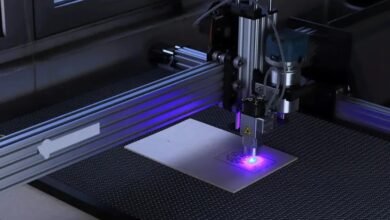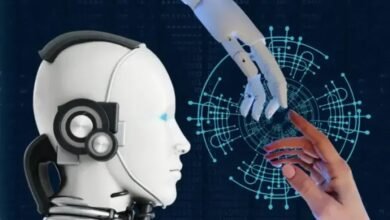The birth of a robot using human cells

The birth of a robot is based on human cells from the trachea. The article discusses the journey of discovery and development that led to this major achievement and highlights the challenges and risks that this exciting technology may face.
Regenerative medicine today represents a branch of science that may be more ripe for surprises than other branches of science. It is not a coincidence that we are witnessing the opening of a new chapter in this field.
The interesting news is the birth of the robot, as an innovative entity in the field of biotechnology, as a result of precise work based on the use of human cells. These cells come, specifically, from the trachea, and in this way, an important step forward in the field of scientific research is achieved. The enormous potential of these robots was recently revealed in an article published in the journal Advanced Science by a group of scientists from Tufts and Harvard Universities in the United States.
Research by Michael Levin Laboratories
This work follows previous research in the laboratories of Michael Levine, the Vannevar Bush Professor of Biology at Tufts University’s College of Arts and Sciences, and Josh Bongard at the University of Vermont, where they created multicellular biological robots from frog embryo cells called xenobots, capable of locomotion. In the hallways, collecting items, record information, heal themselves from injury, and even repeat a few turns on their own.
At the time, researchers did not know whether these abilities depended on them being derived from an amphibian embryo, or whether biobots could be built from cells of other species.
In the current study, published in Advanced Science, Levin, along with doctoral student Gizem Gomoskaya, discovered that robots can in fact be created from adult human cells without any genetic modification, and they have demonstrated some capabilities that go beyond what has been observed with xenobiotics.
This discovery begins to answer a broader question posed by the laboratory, which is: What are the rules that govern how cells gather and work together in the body and give birth to robots? Is it possible to take cells out of their natural context and reassemble them into the body’s various plans for their formation? Implement other functions as designed?
In this case, the researchers gave human cells, after decades of quiescent life in the trachea, a chance to reboot and find ways to create new structures and functions.
“We wanted to explore what cells could do besides creating virtual features in the body,” said Gumoskaya, who earned a degree in architecture before entering the world of biology.
“By reprogramming the interactions between cells, new multicellular structures can be created, similar to the way stone and brick can be arranged into different structural elements such as walls, arches or columns”:
The researchers found that the cells could not only create new multicellular forms but could move in different ways on the surface of human neurons grown in a laboratory dish and encourage new growth to fill in the gaps caused by scratching the cell layer.
It’s not yet clear how the robot encourages the growth of neurons, but the researchers confirmed that neurons grew under the area covered by a cluster of robots, which they called the “giant robot.”
“The cell populations we build in the lab can have capabilities beyond what they do in the body,” said Levin, who also serves as director of the Allen Discovery Center at Tufts University and is an associate faculty member at the Wyss Institute. “It is remarkable and completely unexpected that a patient’s normal tracheal cells, without modifying their DNA, can move on their own and encourage the growth of neurons across the area of damage,” Levine said.
“We are now looking at how the healing mechanism works, and asking what else these combinations can do.”
From the loud to the microscope and the birth of the robot
Researchers have developed Autobots, microscopic biological robots made from human tracheal cells, demonstrating the potential for healing and regenerative medicine.
These self-assembling multicellular robots, which range from the width of a hair to the size of a pencil point, show remarkable therapeutic effects, particularly in growing neurons across damaged areas in laboratory conditions.
Building on previous Xenobot research, this study reveals that robots can be created from adult human cells without genetic modification, providing a new approach to patient-specific therapeutic tools.
Key facts and challenge
- The robots are self-assembling biological robots made from human tracheal cells, capable of locomotion and encouraging nerve cell growth.
- They can be created from adult human cells without genetic modifications, making them a potential patient-specific therapeutic tool.
- Robots represent a major advance in regenerative medicine, potentially helping to treat a variety of diseases and injuries.
These devices display an amazing ability to move independently and self-assemble to form complex structures. These robots range in size from the thickness of a hair to the thickness of a sharpened pencil. However, it offers new perspectives in the field of treating diseases and repairing damaged nerve tissue. This discovery is a turning point in medicine, opening the way to use patient cells as personalized therapeutic tools for cell regeneration.
A journey towards biological engineering
The use of tracheal cells to create robots was chosen based on their structural properties similar to cilia, which transform within these devices into an autonomous means of locomotion.
What makes this approach unique is the absence of modifications to the DNA, as the focus is instead on reshaping cellular interactions. This innovative process allows cells to assemble into new structures, promoting the growth of human neurons without the need for genetic modifications.
Although the exact mechanism behind this phenomenon is not yet fully understood, this innovation promises to revolutionize the way we approach cell regeneration and treat neurodegenerative diseases.
In the near future, when a robot is born, the ethical and social aspects surrounding this scientific innovation will be addressed, highlighting the potential effects on society and the individual. The opinions of experts and scholars in this field will also be comprehensively reviewed, highlighting the diverse opinions between supporters and opponents.
Advantages of using human cells include the ability to build robots from a patient’s own cells to perform therapeutic work without the risk of triggering an immune response or needing immunosuppressants. It lasts only a few weeks before breaking down, so it can easily be reabsorbed into the body after it has finished its work.
Additionally, outside the body, robots can only survive in very specific laboratory conditions, and there is no risk of exposure or unintended spread outside the laboratory. Likewise, they do not reproduce, and have no genetic modifications, additions, or deletions, so there is no risk of them evolving beyond current safeguards.
The impact of the presence of this new robot on the future will be discussed, and how this innovation will constitute a revolutionary shift in fields such as medicine, genetic engineering, and artificial intelligence.




